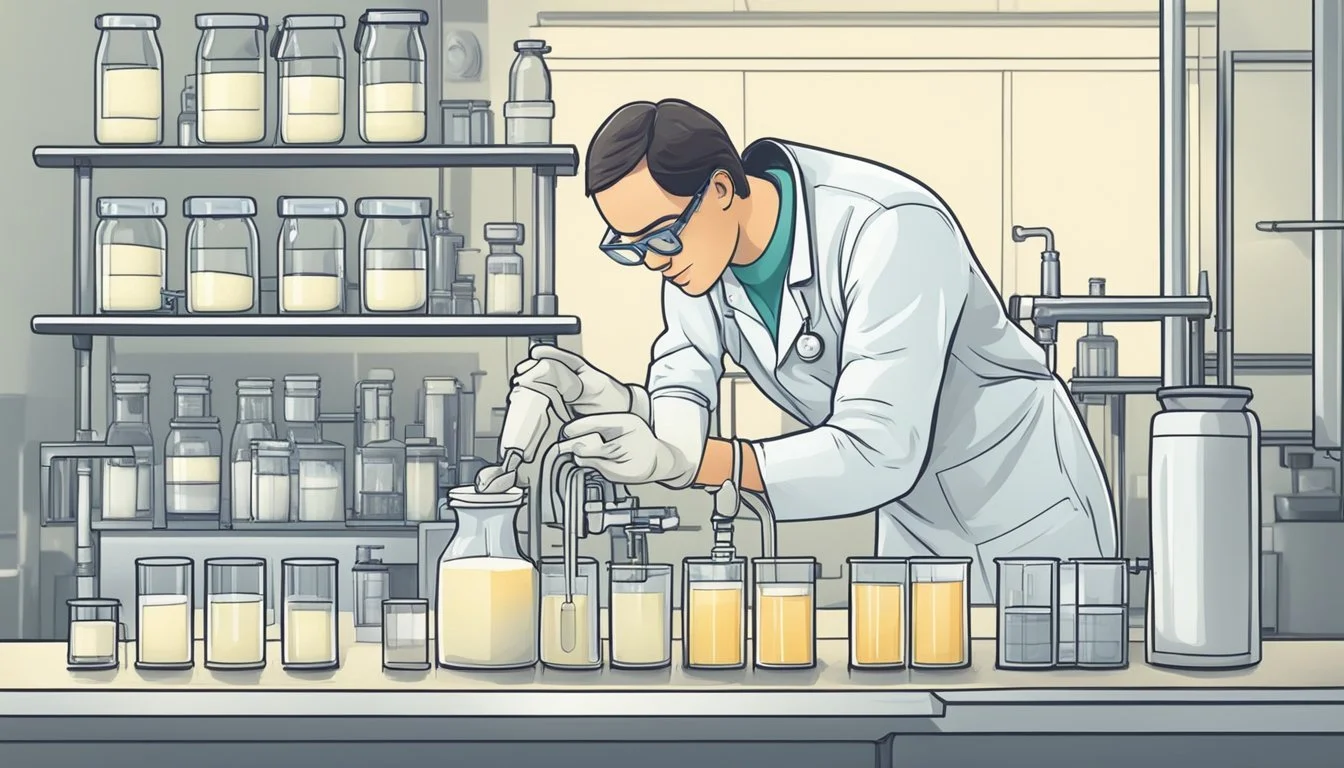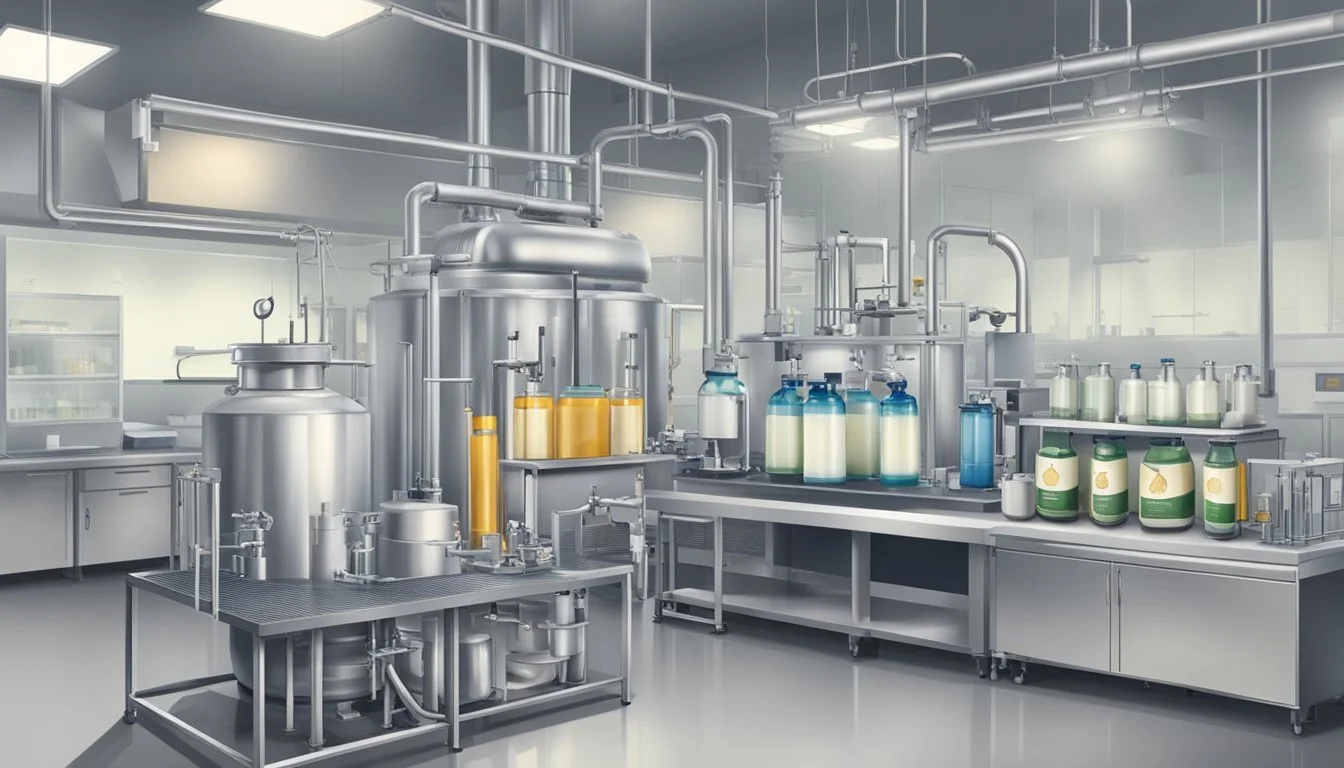The Science of Raw Milk Safety
Ensuring Purity Through Rigorous Testing Methods
Raw milk, which comes directly from the udder of dairy animals, is a source of nutrition that has been consumed by people for thousands of years. Today, it continues to be valued for its rich taste, nutritional benefits, and potential health-promoting properties. However, ensuring the safety of raw milk is of paramount importance due to the inherent risk of harmful microorganisms that can proliferate in unpasteurized milk. The microbiological quality of raw milk is a critical factor that influences not only its safety but also the quality of the dairy products derived from it.
To maintain high-quality standards and guarantee consumer safety, raw milk undergoes rigorous testing for a variety of characteristics. It must be free from debris and sediment, exhibit no off-flavours, abnormal colours, or odours, and possess low bacterial counts. Additionally, it should be devoid of contaminants such as antibiotics and detergents. The evaluation of raw milk includes testing for somatic cell counts, which indicate the health of the dairy animals, as well as for specific pathogens that pose risk to human health.
These microbial and compositional parameters are assessed through established laboratory techniques and standards designed to detect and quantify the presence of contaminants. Producers must adhere to strict guidelines and engage in practices that prioritize hygiene and animal health to limit microbial contamination. A robust approach to ensuring raw milk safety involves farmer education, risk analysis, and management plans tailored to the unique conditions of each farm, which together contribute to a comprehensive strategy for protecting public health.
Understanding The Science of Raw Milk Safety is an illuminating journey that dispels misconceptions and underscores the meticulous care and precision involved in harnessing the nourishing qualities of raw milk. Delving into this realm not only enriches our knowledge but also fosters a deeper appreciation for the art and science of food safety.
Exploring the intricacies of raw milk cure and the nuances of raw milk culinary education unveils the remarkable balance between tradition and innovation, showcasing the diligence and expertise that underpin the safety of raw milk products. Moreover, venturing into the realm of raw milk soap making and reveling in the delight of raw milk homemade ice cream underscores the versatility and creativity inherent in raw milk utilization.
By unraveling misconceptions about raw milk and shedding light on its positive environmental impact, this journey not only promotes informed decision-making but also cultivates a profound respect for the interconnectedness between food, health, and the environment. Embracing The Science of Raw Milk Safety thus becomes a testament to the dedication and expertise that safeguard the purity and wholesomeness of raw milk, ensuring that its journey from farm to table is imbued with care, knowledge, and a deep-rooted commitment to safety.
The Fundamentals of Raw Milk
Raw milk is the unprocessed, unpasteurized milk from cows that presents a unique set of safety challenges due to its microbiological content, while also holding a reputation for nutritional benefits. It is essential to address the nuances of safeguarding the public, while recognizing the value raw milk may offer.
Understanding Raw Milk
Raw milk, directly from the udder of dairy cows, retains its full nutritional value, including vitamins, minerals, enzymes, and proteins. It has not undergone pasteurization, a heat treatment process designed to kill harmful microorganisms. This means the natural microbiota of raw bovine milk, including both beneficial and potentially harmful organisms, remains intact. The composition of raw milk can vary based on feed quality, genetics, and the health of the dairy herd. Dairy farms prioritize milking practices and udder hygiene to manage microbial levels and maintain milk quality.
Food Safety and Public Health Implications
Raw milk can harbor foodborne pathogens which are a concern for public health. These pathogens can include bacteria such as E. coli, Listeria, and Salmonella. Safe consumption of raw milk is reliant on stringent food safety protocols at the dairy farm level, including regular testing for pathogenic microorganisms. To reduce the public health risks, some dairy producers adhere to standards such as the Common Standards for RAWMI LISTED Raw Milk Farmers:
A Risk Analysis and Management Plan (RAMP) for safe milk production.
Regular microbiological tests with a target rolling three-month average of:
less than 10 coliforms per ml of raw milk
less than 5,000 somatic cells per ml of raw milk
Raw Milk shall not contain pathogens, and the presence of these is regularly screened for to ensure safety. Despite these measures, consumers are advised to consider the potential risks, especially among vulnerable groups such as the elderly, infants, pregnant women, and immunocompromised individuals. Moreover, the choice to consume raw milk should be informed by an understanding of the enhanced safety measures implemented by raw milk producers to mitigate risks associated with dairy production.
Raw Milk Microbiology
Raw milk's safety and quality are directly influenced by its microbiology, encompassing the microbial communities present, pathogen detection, and spoilage indicators.
Microbial Communities in Milk
Raw milk is a complex habitat playing host to a variety of microbial life. These microorganisms can originate from the cow's udder, the farm environment, and the milking equipment. The total bacteria count (TBC) reflects the microbiological quality of raw milk, with standards such as ≤100,000 colony-forming units (CFU)/mL at 30 °C for raw cow’s milk. The microbiota in milk typically includes beneficial bacteria with technological importance, as well as mesophilic and psychrotolerant bacteria important for dairy processing. Somatic cell count (SCC) is another crucial indicator of milk hygiene, where elevated levels can indicate mastitis or infection in the milk-producing animal.
Pathogen Detection and Identification
Pathogens in raw milk pose significant health risks, necessitating rigorous detection and identification protocols. Common routes of contamination stem from the animal itself, environmental factors, and handling processes. Reliable pathogen identification methods are critical for ensuring raw milk is safe for consumption, as it may contain dangerous microorganisms like E. coli, Listeria, and Salmonella. Therefore, regulatory practices enforce routine evaluation of raw milk for pathogen presence to maintain consumer safety.
Spoilage Microorganisms and Indicators
Spoilage microorganisms, such as certain spore-forming bacteria, can compromise raw milk's safety and shelf life. These include bacteria that may not initially be active but can later cause spoilage or foodborne illness. Indicators of spoilage are often assessed through various tests such as viable cell counts; counts higher than 5 log CFU/mL suggest poor hygienic practices during milk collection. The presence of these bacteria and their spores is a significant factor in determining the microbiological quality of raw milk and is a focus during routine testing to ensure quality and safety.
Testing and Quality Assurance
Ensuring the safety of raw milk involves a rigorous process of testing and quality assurance. This process includes specific techniques to detect microbiological contamination, adherence to established quality standards, and a clear interpretation of microbiological parameters to meet regulatory compliance.
Microbiological Testing Techniques
Microbiological testing is a critical control point in the safety assessment of raw milk. Laboratories perform several testing methods to measure the presence and levels of pathogens, with common tests including the plate count method and the somatic cell count. The plate count method, performed at 30°C, quantifies the colony-forming units per milliliter (cfu/ml) to determine the bacterial load. The somatic cell count is another vital parameter that indicates the quality of milk, with higher counts suggesting possible mastitis in the milking herd.
Establishing Raw Milk Quality Standards
Quality standards for raw milk are set to ensure both safety and nutritional value. These standards include maximum limits for microbial content and somatic cell counts that are often defined in regulatory guidelines like Regulation (EC) 853/2004. For example, a typical regulatory limit for total bacterial count might be set at 100,000 cfu/ml. These standards act as a benchmark for dairy producers to achieve and maintain to avoid penalties and to guarantee that the milk is fit for consumption and further processing.
Interpreting Microbiological Parameters
Statistical analysis plays a vital role in interpreting the results from microbiological testing. The data must be carefully analyzed to identify trends and to ensure that the milk consistently meets or exceeds the established safety criteria. Interpretation involves comparing the test results to the maximum limits set by authorities. If the results show bacterial counts exceeding these limits, the raw milk is deemed unsafe for consumer intake and is not processed further until the issue is resolved.
By maintaining strict testing protocols and standards, the dairy industry can provide safer raw milk products to consumers while also protecting public health.
Safety Regulations and Compliance
In the realm of dairy production, safety and quality are paramount. This section examines the framework governing the safety regulations and assessment processes ensuring the compliance of raw milk.
Global and Regional Dairy Guidelines
Different regions have established guidelines to maintain the safety and quality of raw milk. The European Food Safety Authority (EFSA) is a key entity in the European Union that sets safety standards for food, including dairy. These guidelines often include:
Microbiological criteria: Targeted at pathogens such as Listeria monocytogenes, Salmonella Enterica, Campylobacter spp., and Escherichia coli O157.
Chemical standards: Focus on monitoring residues from veterinary medicines and contaminants.
Somatic cell count: An indicator of milk quality and udder health.
Raw Milk Safety Limits and Regulations
Safety limits and regulations are critical in mitigating health risks associated with raw milk consumption. These are some standards typically enforced:
Plate count at 30 °C: Used to measure the bacterial load in milk; higher counts may indicate poor hygiene during milking or storage.
Somatic cell count: Regulatory limits are established to assess animal health; high counts can indicate mastitis in dairy herds.
Regulatory bodies also conduct tests for serious diseases like tuberculosis and brucellosis, which can be transmitted to humans through raw milk. Policies are structured to provide comprehensive oversight to safeguard public health.
Environmental Factors and Milk Safety
Contamination of raw milk often occurs post-extraction through interaction with the environment, which underscores the need for strict sanitary practices on dairy farms.
Effect of Dairy Farm Environment
The safety and quality of raw milk are significantly influenced by the conditions in which dairy cattle are raised. Environmental sources of contamination can include bacteria from soil, water, feed, and fecal matter. Effective management practices on dairy farms must ensure clean surroundings to minimize contamination. Elements such as proper waste disposal, routinely sanitized equipment, and good housing conditions for the animals are crucial. These measures help maintain the milk's integrity from the moment it is expressed from the udder, yielding quality dairy products.
Seasonal Variations in Milk Quality
Seasonality and weather patterns play a fundamental role in raw milk quality. Fluctuations in temperature and humidity may affect the bacterial count and composition of milk. For instance, higher temperatures in the summer can accelerate bacterial growth, necessitating faster cooling processes post-milking. Conversely, winter conditions may lower bacterial proliferation but can still pose risks if not managed properly. Dairy farms must adapt their procedures to these seasonal changes to ensure their milk meets safety standards throughout the year. Implementing strategies such as adjusting feeding protocols and enhancing barn ventilation can help maintain consistent milk quality regardless of the season.
Farming Practices and Animal Health
Ensuring raw milk safety and quality significantly depends on farm management, with a primary focus on milking hygiene, disease management, and the overall hygiene of the dairy cattle.
Milking Hygiene Practices
Effective handling of equipment and adherence to strict milking protocols are crucial for maintaining the safety of raw milk. Farms should implement standardized procedures for cleaning and sanitizing all milking equipment before and after each use to prevent contamination. The milking process itself should be done carefully to avoid introducing pathogens from the environment or the handler's skin into the milk.
Handling and Equipment: Sanitize teat cups, milk lines, and storage tanks after each milking session.
Milking Protocol: Train staff in proper milking techniques to ensure minimal contact with udders and to prevent bacterial transfer.
Disease Management in Dairy Cattle
Dairy farms must have proactive strategies to monitor and manage illnesses, especially clinical mastitis, which directly impacts milk production and safety. Regular health screenings and prompt treatment of sick animals reduce the risk of disease spread and contamination of the milk supply.
Clinical Mastitis: Implement regular screening for early detection and isolate affected cattle to prevent the spread of infection.
Milk Production Safety: Monitor milk from individual cows for signs of infection and withhold it from the supply as necessary.
Impact of Cow Hygiene Factors
Cow hygiene plays a pivotal role in the overall quality of milk. Cows' housing areas should be kept clean, dry, and well-bedded to minimize external contamination. Regular grooming and bathing of the cows, particularly the udders, are important to maintain cleanliness at the point of milking.
Cow Hygiene Factors: Regularly clean living spaces and employ udder washing before milking to minimize bacterial load.
Dairy Farm Hygiene: Assess farm cleanliness, including water supply and feed quality, as they can affect cow health and milk safety.
Processing and the Fate of Raw Milk
The journey of raw milk from collection at the farm through processing and to the consumer, involves critical steps to ensure safety and quality. At each stage, from handling and storage to the conversion into various dairy products, strict protocols are followed to maintain milk hygiene and assure the quality of the final processed dairy products.
From Farm to Table: Handling and Storage
Proper handling and storage of raw milk are essential for maintaining its quality until processing. After collection, raw milk must be cooled to 4°C (39°F) or lower to slow bacterial growth. Tanks used for transportation should be refrigerated and sanitized to prevent contamination. Dairy farms adhere to stringent milk hygiene protocols to ensure that the raw milk is of high quality even before it reaches processing facilities.
Conversion to Processed Dairy Products
Once at the processing plant, raw milk can be transformed into a variety of dairy products, including cheese, butter, and various dairy foods. Each product requires specific processing steps. For cheese-making, raw milk is pasteurized, cultured, and coagulated before being shaped and aged. In butter production, cream separated from raw milk is churned. Every processed dairy product must meet regulatory standards to ensure consumer safety.
Assurance of Processed Product Quality
Ensuring the quality of processed dairy products is a multifaceted approach that includes:
Microbiological Testing: Regular testing for pathogens and spoilage organisms.
Chemical Analysis: Checking for contaminants and verifying composition.
Sensory Evaluation: Assessing taste, smell, and texture for defects.
Processed dairy product quality is directly linked to the initial quality of raw milk, and ongoing monitoring of these factors is essential for high-quality, safe consumer products.
Advanced Topics in Dairy Safety
The safety of dairy products hinges upon rigorous detection of contaminants and sophisticated statistical analysis for quality assurance. Both processes play a critical role in mitigating risks associated with bacterial contamination and ensuring the integrity of the food supply.
Innovations in Detection of Contaminants
In recent years, the dairy industry has seen significant advancements in methods for detecting pathogens in raw milk. Traditional culture-based detection systems are being supplemented or replaced by rapid diagnostic techniques such as polymerase chain reaction (PCR) and enzyme-linked immunosorbent assays (ELISA). These innovative methods offer faster and more precise identification of foodborne pathogens, a critical factor in preventing the distribution of contaminated dairy products. Microbial load tests continue to be indispensable in evaluating the overall quality and safety of raw milk.
PCR: Detects the genetic material of bacteria, enabling identification within hours.
ELISA: Utilizes antibodies to detect specific food safety hazards, including bacterial toxins and contaminants.
Statistical Analytics in Dairy Quality Control
Quality control in the dairy industry is continually refined through the application of statistical analytics. These techniques involve the collection and analysis of large datasets to monitor control points within the production process, thus informing management decisions and enhancing food safety measures.
Descriptive Statistics: Provides a summary of collected data and helps in understanding the characteristics of milk quality variables.
Predictive Analytics: Uses patterns in historical data to predict future safety risks, allowing preemptive action to minimize contamination incidents.
These analytic approaches lead to more data-driven decision-making and have reshaped quality control processes throughout the dairy industry. By utilizing statistical analysis, producers can act swiftly to address potential issues, maintaining the safety of the food supply and consumer confidence in dairy products.
Practical Implications and Future Directions
In the context of dairy product quality and public health implications, implementing strategic practices and enhancing awareness are paramount.
Implementing a Whole-Farm Approach
The whole-farm approach looks at milk safety from the dairy farm to the end consumer. It involves the integration of data-driven, risk-based tools that monitor and control the quality of milk throughout its production and processing stages. Utilizing this approach ensures that all variables impacting milk quality, from feeding and cow health to milking, storage, and transportation, are managed cohesively. For instance, regular testing for total bacteria count serves as a key indicator of raw milk quality. By employing these comprehensive strategies, farmers can sustain high standards of hygienic practices which directly correlate to safer dairy products.
Public Health Education and Awareness
Effective public health education is essential to convey the importance of safe raw milk consumption. Initiatives to inform consumers about the benefits and risks associated with raw milk should be clear and based on scientific evidence. Programs designed to increase the knowledge of safe handling and consumption practices can significantly reduce health risks. At the farm level, grants and support for on-farm testing facilities can empower producers to regularly assess the safety of their milk, fostering a proactive culture of food safety. These measures collectively serve to protect public health while supporting the viability of raw milk as a nutritional product.





